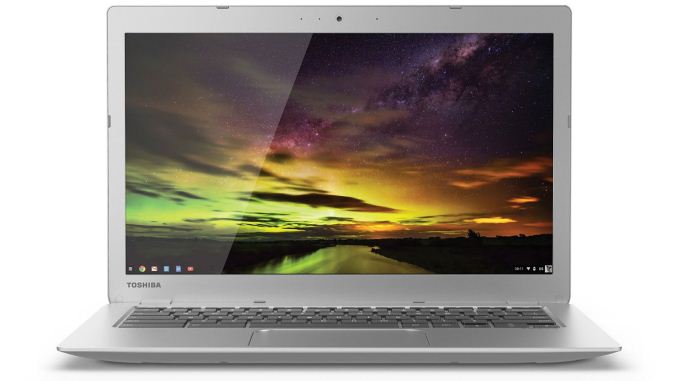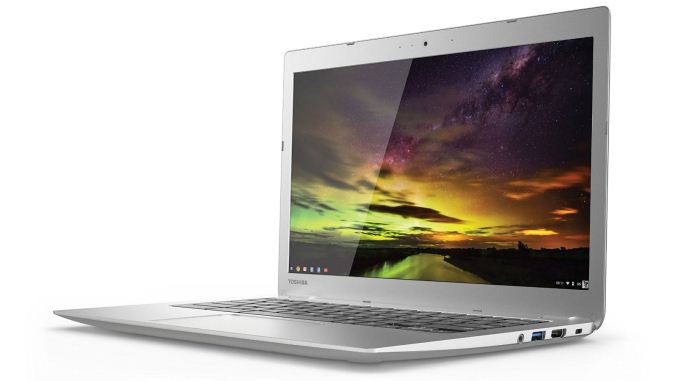Toshiba Chromebook 2: A Feast for the Eyes
by Jarred Walton on February 11, 2015 10:00 AM EST
Toshiba Chromebook 2 with 1080p IPS
We often complain about the effects of the race to the bottom – the race to the lowest possible price, regardless of what effect that has on overall quality. For more than a decade we’ve seen very little in the way improvements in display quality on laptops, with the primary change being the switch from CCFL backlighting to LEDs. In fact, it really wasn’t until the tablet market exploded that we started to see true improvements in laptop displays – or if you prefer, it was roughly around the time that Apple first released their MacBook Pro Retina.
Whatever you want to attribute the change to, there has been an increase in demand for good quality laptop displays, and that in turn has driven down the prices on such displays. Huzzah! We’re still a long way from putting TN panels behind us, but it’s now possible to find good displays in a laptop at price points well below $1000, which is great news. And it’s something that needs to continue to happen, as tablets are pretty much a guarantee that you’re going to get something better than a TN panel with a 250:1 contrast ratio; with tablet performance creeping ever closer to that of budget laptops, you can definitely make the argument for just getting a tablet with a keyboard...but that’s still a tablet with a keyboard rather than a laptop.
Chromebooks basically target that niche where there’s a desire for a true laptop experience, though obviously with some other qualifications. We've covered these before, but the biggest is that users need to be willing to leave behind the world of Windows and move to a new OS, but again with the proliferation of tablets, smartphones, Apple’s OS X devices, and a greater reliance on Internet and cloud-based services, people in general have become far less attached to their OS. Along with that, you need applications to perform everyday functions, with the Google Chrome App Store filling that role.
Chrome OS and the Chrome App Store also gives users the walled garden experience, ensuring that you won’t become a victim of the latest viruses and malware. It’s true that you can get a lot of that with iOS and Android, but Windows users at least have generally rejected that approach. And the Windows software developers are opposed to having a fully curated app store as well – look no further than Valve and their Steam OS initiative to see an example of this. For better or worse, Windows has a legacy of openness, and as the largest share of installed PCs it’s not something easily changed. At the same time, a lot of money ends up being poured into antivirus and antimalware tools, not to mention the support costs, so many are looking for an alternative. They’re saying, “Let Windows be Windows, but give me something easy to use and maintain.” For Google, Chrome OS is that something else.
Getting to the Toshiba Chromebook 2, let’s hit the spec sheet before we go any further. It’s important to note that there are actually three models of the Toshiba Chromebook 2 available, and when we say “Toshiba Chromebook 2” throughout this review we’re specifically referring to the model with the 1080p IPS display that we’re testing, also called the Toshiba Chromebook CB35-B3340. The Toshiba CB35-A3120 is actually the original Toshiba 13” Chromebook and sports a 1366x768 TN display with a Celeron 2955U, while the CB35-B3330 is the same as the model we’re reviewing but with a 1366x768 TN display and 2GB RAM.
| Toshiba Chromebook 2 CB35-B3340 Specifications | |
| Processor | Intel Celeron N2840 Dual-core 2.16-2.58GHz HD Graphics 4 EU GPU |
| Connectivity | 2x2 dual-band 802.11ac (Intel 7260NGW) Bluetooth 4.0 (Intel 7260NGW) |
| Memory | 4GB DDR3L |
| Storage | 16GB eMMC |
| Battery | 3-cell ~10.8V, 3860mAh, 44Wh |
| I/O | 1 x USB 3.0 1 x USB 2.0 HD webcam Dual array microphone HDMI Headphone/mic jack SD Card reader |
| Dimensions | 12.6" x 8.4" x 0.76" / 320 x 213 x 19.3 mm |
| Display | 13.3-inch IPS 1920x1080 |
| Weight | 2.95 lbs. / 1340g |
| Price | $330 MSRP, $329 Online |
Besides the inclusion of a great display – more on that in a moment – the remaining specs are pretty typical of Chromebooks. The processor of choice this time is Intel’s Celeron N2840, a dual-core Bay Trail chip running at 2.16-2.58GHz. The GPU portion of the chip is based on Intel’s HD Graphics architecture, the same architecture in Ivy Bridge and Haswell processors, but with only 4 EUs active. By comparison, the Celeron 2955U has 10 EUs, and they’re clocked higher as well, making the 2955U graphics potentially 2.5-3X faster. Whether or not that ends up being important is something we’ll discuss in our benchmark section.
Other features include two USB ports – one 2.0 and one 3.0 – an SD card reader, and a full size HDMI port. You also get 4GB of DDR3 memory (non-upgradeable) and 16GB of eMMC storage (plus 100GB of Google Drive storage for two years). The battery is a 3-cell 44Wh model rated for up to nine hours of battery life, which is good though not class leading. Compared to Windows laptops, some of the specs might seem a bit limited, but we’re talking about a $329 laptop with a good display, which is something you can’t currently find in the Windows laptop space. (Windows tablets however….)











66 Comments
View All Comments
RadioShackLives - Wednesday, February 18, 2015 - link
I really enjoyed this review.I bought the Toshiba CB35-A3120 13.3-Inch Chromebook last year for my girlfriend. I am a graduate student studying computer science and have experience with OSX, Windows, Linux, and Chrome OS. With the chromebook I don't have to spend an hour every month removing viruses from the PC the way I did with her Windows laptop. If anyone has to deal with supporting Windows for friends and family Chrome OS is a great alternative.
I also installed Ubuntu on my girlfriend's chromebook. I downloaded Sublime Text and Libre Office. I also downloaded Ruby and was able to run some Ruby programs I created without any issue. Keep in mind the Chromebook I used had the Celeron 2955U processor. I'm curious if Bay Trail would be much different.
The only downside is to get crouton you ha be to leave the chromebook in developer mode so it won't boot up as quickly. However I like the combination of linux + chrome OS. Linux lets me work on coding assignments but when I want to watch HBOGO I can switch over to chrome OS.
Lastly, don't be one of these jokers that complains about not being able to run Photoshop. You remind me of the people that buy ultrabooks on Amazon and complain that there is no DVD drive.
tipoo - Tuesday, March 1, 2016 - link
Jeeze, what was she doing to get a virus a month?sirkiwi - Thursday, March 5, 2015 - link
I am pleasantly surprised that such an inexpensive product can come with such a high quality 13.3" 1080p screen. Now, if only we could get that on a Windows notebook. The fact that we can't is just outright infuriating.calexander16 - Tuesday, April 14, 2015 - link
Beware of the Toshiba Chromebook 2 - there appears to be a quality issue with its display.After four months of normal laptop use, a crack developed in the membrane (?) behind the display glass. I sent pictures to Toshiba for the warranty claim - and they rejected it, claiming "physical damage" was done to the machine.
If opening and closing the lid normally is considered physical damage, I guess they're right.
Wondering if I was the lone crank in the Toshiba electronics universe, I went onto Amazon - and lo and behold, under the 1-star reviews there are several reports of display cracks and problems for the Toshiba Chromebook Two within the first few months of ownership. In all of the cases, Toshiba refused to honor its warranty service for these problems.
So be very careful. I suspect a Quality Control issue - and tried to uplevel my concern to Toshiba but met a dead-end in the customer service department.
mbhatia - Saturday, October 17, 2015 - link
Can someone please assist me advising how I can lock an OFFLINE folder/file etc in a Chromebook...on an attached SD card etc. One needs to remain stuck in there because of the low internal memory and I while the Cloud portion of the chromebook is secure, anyone can take out the SD card and access the contents of an unsecured folder. There are apps for this Android and Windows and making a secure drive etc in Mac... how do I achieve something so basic in a Chromebook? This is the only piece of the puzzle missing for me in adopting this full time and loading it up with my data.George.Madison - Thursday, November 26, 2015 - link
You know, I'm a very demanding customer. One day a came to a conclusion that billion corporations around the globe produce their stuff in order to: 1 - sell their products; 2 - truly help people and make their lives easier. First aim is much more valuable than second!That's the reason I always demand products appropriate to thier prices.
Toshiba laptop costs nearly $270 http://cent.im/popular/259/toshiba_chromebook_2
For this amount you receive 13,3'' Full HD screen (which I consider the best decision), fast SSD inside, 4 Gb RAM and 64-bit Windows.
Keyboard is quite convenient. As for mouse, I use my old Logitech.